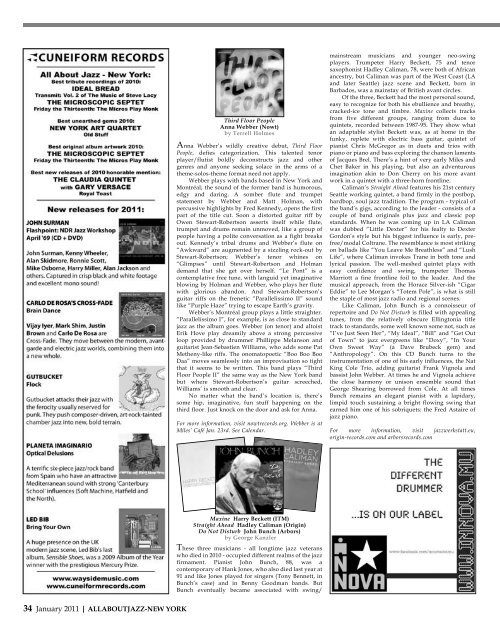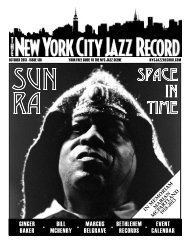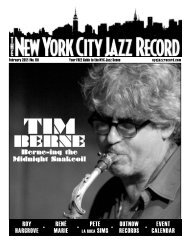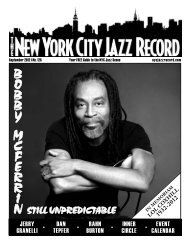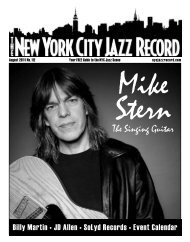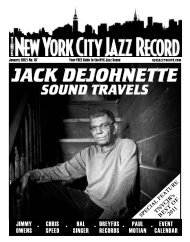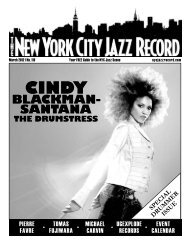heart of gold - The New York City Jazz Record
heart of gold - The New York City Jazz Record
heart of gold - The New York City Jazz Record
You also want an ePaper? Increase the reach of your titles
YUMPU automatically turns print PDFs into web optimized ePapers that Google loves.
34 January 2011 | ALLABOUTJAZZ-NEW YORK<br />
Third Floor People<br />
Anna Webber (Nowt)<br />
by Terrell Holmes<br />
Anna Webber’s wildly creative debut, Third Floor<br />
People, defies categorization. This talented tenor<br />
player/flutist boldly deconstructs jazz and other<br />
genres and anyone seeking solace in the arms <strong>of</strong> a<br />
theme-solos-theme format need not apply.<br />
Webber plays with bands based in <strong>New</strong> <strong>York</strong> and<br />
Montréal; the sound <strong>of</strong> the former band is humorous,<br />
edgy and daring. A somber flute and trumpet<br />
statement by Webber and Matt Holman, with<br />
percussive highlights by Fred Kennedy, opens the first<br />
part <strong>of</strong> the title cut. Soon a distorted guitar riff by<br />
Owen Stewart-Robertson asserts itself while flute,<br />
trumpet and drums remain unmoved, like a group <strong>of</strong><br />
people having a polite conversation as a fight breaks<br />
out. Kennedy’s tribal drums and Webber’s flute on<br />
“Awkward” are augmented by a sizzling rock-out by<br />
Stewart-Robertson; Webber’s tenor whines on<br />
“Glimpses” until Stewart-Robertson and Holman<br />
demand that she get over herself. “Le Pont” is a<br />
contemplative free tune, with languid yet imaginative<br />
blowing by Holman and Webber, who plays her flute<br />
with glorious abandon. And Stewart-Robertson’s<br />
guitar riffs on the frenetic “Parallelissimo II” sound<br />
like “Purple Haze” trying to escape Earth’s gravity.<br />
Webber’s Montréal group plays a little straighter.<br />
“Parallelissimo I”, for example, is as close to standard<br />
jazz as the album goes. Webber (on tenor) and altoist<br />
Erik Hove play dreamily above a strong percussive<br />
loop provided by drummer Phillippe Melanson and<br />
guitarist Jean-Sebastien Williams, who adds some Pat<br />
Metheny-like riffs. <strong>The</strong> onomatopoetic “Boo Boo Boo<br />
Daa” moves seamlessly into an improvisation so tight<br />
that it seems to be written. This band plays “Third<br />
Floor People II” the same way as the <strong>New</strong> <strong>York</strong> band<br />
but where Stewart-Robertson’s guitar screeched,<br />
Williams’ is smooth and clear.<br />
No matter what the band’s location is, there’s<br />
some hip, imaginative, fun stuff happening on the<br />
third floor. Just knock on the door and ask for Anna.<br />
For more information, visit nowtrecords.org. Webber is at<br />
Miles’ Café Jan. 23rd. See Calendar.<br />
Maxine Harry Beckett (ITM)<br />
Straight Ahead Hadley Caliman (Origin)<br />
Do Not Disturb John Bunch (Arbors)<br />
by George Kanzler<br />
<strong>The</strong>se three musicians - all longtime jazz veterans<br />
who died in 2010 - occupied different realms <strong>of</strong> the jazz<br />
firmament. Pianist John Bunch, 88, was a<br />
contemporary <strong>of</strong> Hank Jones, who also died last year at<br />
91 and like Jones played for singers (Tony Bennett, in<br />
Bunch’s case) and in Benny Goodman bands. But<br />
Bunch eventually became associated with swing/<br />
mainstream musicians and younger neo-swing<br />
players. Trumpeter Harry Beckett, 75 and tenor<br />
saxophonist Hadley Caliman, 78, were both <strong>of</strong> African<br />
ancestry, but Caliman was part <strong>of</strong> the West Coast (LA<br />
and later Seattle) jazz scene and Beckett, born in<br />
Barbados, was a mainstay <strong>of</strong> British avant circles.<br />
Of the three, Beckett had the most personal sound,<br />
easy to recognize for both his ebullience and breathy,<br />
cracked-ice tone and timbre. Maxine collects tracks<br />
from five different groups, ranging from duos to<br />
quintets, recorded between 1987-95. <strong>The</strong>y show what<br />
an adaptable stylist Beckett was, as at home in the<br />
funky, replete with electric bass guitar, quintet <strong>of</strong><br />
pianist Chris McGregor as in duets and trios with<br />
piano or piano and bass exploring the chanson laments<br />
<strong>of</strong> Jacques Brel. <strong>The</strong>re’s a hint <strong>of</strong> very early Miles and<br />
Chet Baker in his playing, but also an adventurous<br />
imagination akin to Don Cherry on his more avant<br />
work in a quintet with a three-horn frontline.<br />
Caliman’s Straight Ahead features his 21st century<br />
Seattle working quintet, a band firmly in the postbop,<br />
hardbop, soul jazz tradition. <strong>The</strong> program - typical <strong>of</strong><br />
the band’s gigs, according to the leader - consists <strong>of</strong> a<br />
couple <strong>of</strong> band originals plus jazz and classic pop<br />
standards. When he was coming up in LA Caliman<br />
was dubbed “Little Dexter” for his fealty to Dexter<br />
Gordon’s style but his biggest influence is early, prefree/modal<br />
Coltrane. <strong>The</strong> resemblance is most striking<br />
on ballads like “You Leave Me Breathless” and “Lush<br />
Life”, where Caliman invokes Trane in both tone and<br />
lyrical passion. <strong>The</strong> well-meshed quintet plays with<br />
easy confidence and swing, trumpeter Thomas<br />
Marriott a fine frontline foil to the leader. And the<br />
musical approach, from the Horace Silver-ish “Cigar<br />
Eddie” to Lee Morgan’s “Totem Pole”, is what is still<br />
the staple <strong>of</strong> most jazz radio and regional scenes.<br />
Like Caliman, John Bunch is a connoisseur <strong>of</strong><br />
repertoire and Do Not Disturb is filled with appealing<br />
tunes, from the relatively obscure Ellingtonia title<br />
track to standards, some well known some not, such as<br />
“I’ve Just Seen Her”, “My Ideal”, “Bill” and “Get Out<br />
<strong>of</strong> Town” to jazz evergreens like “Doxy”, “In Your<br />
Own Sweet Way” (a Dave Brubeck gem) and<br />
“Anthropology”. On this CD Bunch turns to the<br />
instrumentation <strong>of</strong> one <strong>of</strong> his early influences, the Nat<br />
King Cole Trio, adding guitarist Frank Vignola and<br />
bassist John Webber. At times he and Vignola achieve<br />
the close harmony or unison ensemble sound that<br />
George Shearing borrowed from Cole. At all times<br />
Bunch remains an elegant pianist with a lapidary,<br />
limpid touch sustaining a bright flowing swing that<br />
earned him one <strong>of</strong> his sobriquets: the Fred Astaire <strong>of</strong><br />
jazz piano.<br />
For more information, visit jazzwerkstatt.eu,<br />
origin-records.com and arborsrecords.com


